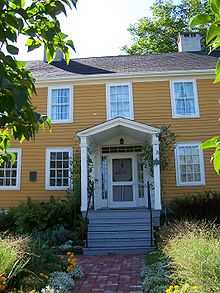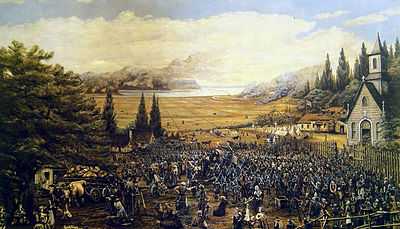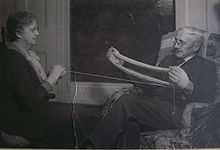Wolfville Historical Society
The Wolfville Historical Society is tasked with the maintenance and promotion of the history of the town of Wolfville, Nova Scotia and its surrounding area. The Society employs staff and volunteers to maintain a seasonal museum at the Randall House in Wolfville, and to collect and preserve local historical documents and artefacts from the surrounding area. The Society also supports the publication of books written about Wolfville's history.

A short history of Wolfville
The first inhabitants
The area of Wolfville, from 14,000 BC to 1000 AD was a hunting ground for many First Nations peoples including the Clovis, Laurentian, Bear River, and Shields Archaic groups. They were attracted by the salmon in the Gaspereau River and the agate stone at Cape Blomidon with which they could make stone tools. In around 700 AD, the first Mi'kmaq, related to the Algonquin and Ojibwe peoples, migrated into Nova Scotia and bumped the other tribes out. The Mi'kmaq were seasonal hunters, using dogs and webbed snowshoes to hunt deer, and using the various semi-precious stones (including jasper, quartz, and even amythest) from the Blomidon area to make arrowheads. When Samuel de Champlain and Pierre Dugua, Sieur de Mons founded the habitation at Port Royal, the Mi'kmaq helped the French survive the dreadful winter of 1606-1607. Samuel de Champlain would return and tell in France of the good fertile land in the Annapolis Valley. This paved the way for the Acadians to come and settle.

The Acadians
The Acadians settled in the Annapolis Valley as early as 1650, and more strongly between 1670 and 1682, and by 1693, their population numbered about 350.[1] Their primary settlement was at Grand-Pré. The Acadians prospered as small-time farmers, and had success in dyking off land to reclaim fertile soil. In 1713, however, Acadia was no longer under the French crown; the Treaty of Utrecht, which represented the end of the War of the Spanish Succession, gave the territory of Acadia to the British. They had suddenly come into possession of several hundred French-speaking Catholic subjects. Much as the Acadians simply wanted out of the politics and conflict, the French wanted to use them as subversives, and the British were suspicious of them for that very reason. After the Battle of Grand Pré in the War of the Austrian Succession, the French retained control of the Acadians until 1755, when they were forced out by the British in the Bay of Fundy Campaign (1755). The British then deported over 2,000 Acadians in September and October of that year, and they destroyed Grand Pré on 10 October.
The New England Planters

Around 1760, the British government in Nova Scotia made several plots of land available in the Annapolis Valley for colonization. Because of pressure on agricultural lands in New England, anglophone farmers moved North in search of fertile land at a reasonable price. It is thought that between 1760 and 1789 more than 8 000 people emigrated to the land around the Annapolis Valley. They settled, and re-used a great deal of the same system that the Acadians had used before them, appropriating and repairing the dykes. In 1763, there were 154 families living in the area of Horton Township. The New England Planters set up a primarily agricultural economy, especially in apples. They enlarged and expanded the Acadian dykes including a dramatic expansion in 1808, the three mile long Wickwire Dyke located on the dykelands across from Randall House. It which connected the Wolfville and Grand Pre dykes opening up an additional 8,000 acres, although it was later reduced in size by erosion from the Cornwallis River.[2] Between 1828 and 1830, the town of Mud Creek switched its name to Wolfville, supposedly in honour of Elisha DeWolf, Jr., the town's postmaster at the time. In the mid-19th century, Wolfville was renowned as the world's smallest port. Acadia University was founded in 1838 as a Baptist college. The town welcomed Confederation in 1867. In 1872, a railway was put in that led from Annapolis Royal to Halifax. On 20 March 1893, the Town of Wolfville was incorporated with Dr. E. Perry Bowles as its first mayor. The town participated in Canada's wartime effort during World War I, World War II, and the Korean War. SInce then the town has grown to be Canada's First Fair Trade Town, with a population of 3,772 according to the 2006 census.
The Randall House
While the date of construction is unknown, the first recorded owner of the house was Aaron Cleveland, a tradesman living in Wolfville around 1805.[3] On 14 November 1812, Cleveland sold the property to a carpenter by the name of Charles Randall. Upon his death in 1856, the property passed to his son, Charles Dennison Randall, listed as a prosperous English-descended Baptist magistrate. When he died in 1893, his will stated that the property was to be split between his daughters, Elizabeth and Annie. Eardley Randall spent most of his time caring for "sister" Annie, who was an invalid and never left the house. Eardley Randall's initials are still carved into the attic's staircase. Under Eardley's ownership, the property gained a reputation of neglect, and often was regarded as a spooky place by the town children. In 1927, Eardley and Elizabeth sold the land to a merchant, William C.B. Harris, who in turn sold it to the retired farmer, Charles Patriquin. Over the course of his retirement, C.A. Patriquin spent time and money to brighten up the area of Wolfville now known as Willow Park, next to the Randall House. Until then, it had been a swampy area and an eyesore. He passed the land on to his son, Graham, in 1932. In 1941, it was proposed that the old DeWolf house be demolished, the Wolfville Historical Society was founded by a group of concerned citizens who rented the property and turned the DeWolf House into a museum. In 1946, the Wolfville Fruit Company, who owned the land, decided they wanted to use the site, the museum had to be moved. Graham Patriquin sold the Randall House in 1947, and the Wolfville Historical Society now leases the property for one dollar a year. The Randall House Museum was opened up in 1949. It won status as a Nova Scotia Provincial Heritage Property in 1987. For the past four years, the Wolfville Historical Society has been following a program to renovate the Randall House Museum, paid for by the donations of its members and the support of the municipal and provincial governments.
See also
Notes
- ↑ James Doyle Davison, ed. (1985). Mud Creek: The Story of the Town of Wolfville, Nova Scotia. Wolfville, N.S.: Wolfville Historical Society.
- ↑ Sherman Blakeney, Sods, Soils and Spades, McGill Queens University Press (2004) p. 140
- ↑ Heather Davidson (1993). A History of the Randall House. Wolfville, N.S.: Wolfville Historical Society.